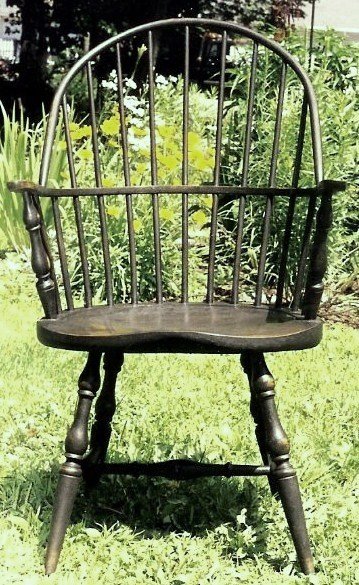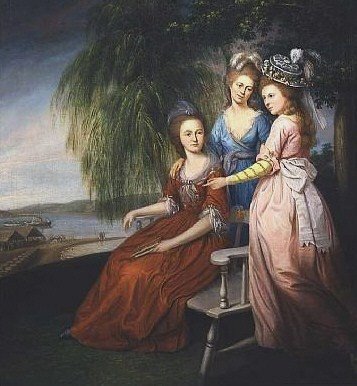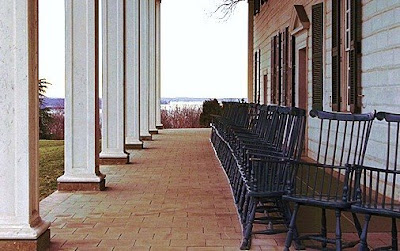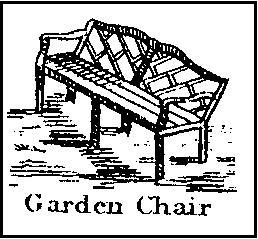Encounters with America’s Premier Nursery & Botanic Garden
The Prince Nursery of New York City
Their journey did, nevertheless, incorporate elements of a working vacation, for Jefferson was seeking ways to advance the new nation through alternative domestic industries. He believed his most recent idea—the addition “to the products of the U. S. of three such articles as oil, sugar, and upland rice”—would lessen America’s reliance on foreign trade, improve the lot of farmers, and ultimately result in the abolition of slavery itself. At that time a Quaker activist and philanthropist Dr. Benjamin Rush of Philadelphia, himself an ardent opponent of slavery, was seeking ways to convince political leaders and slave owners to create a sugar maple industry in America, convinced it would “lessen or destroy the consumption of West Indian sugar, and thus indirectly to destroy negro slavery.” Jefferson took up the cause of Benjamin Rush, becoming a conscientious consumer of maple sugar much in the way that modern environmental activists boycott plantation grown coffee today. In a letter to a friend in England, Jefferson expressed the political and humanitarian benefits of commercial independence when he wrote, “What a blessing to substitute a sugar which requires only the labour of children, for that which it is said renders the slavery of the blacks necessary.”
In their quest for the sugar maple, Jefferson and Madison made a noteworthy visit to the Prince Family Nursery in Flushing on the north shore of Long Island, New York. Established on eight acres of land in the 1730s by Robert Prince—within a community chiefly of French Huguenot settlers—it became America’s first commercial nursery and remained a thriving family business through four generations, until just after the Civil War. Initially called the “Old American Nursery,” it soon became the largest supplier of fruit trees and grapes in the New World, producing most of the grafted apple, pear, and cherry trees that could be found in early northeastern orchards.
Robert’s son William Prince, the nursery’s second proprietor and the one who was in charge at the time of Jefferson’s visit, was the first to propagate the native pecan commercially. In 1771, the nursery’s first broadside advertised 33 different plum trees, 42 pear trees, 24 apple trees and 12 varieties of nectarines. Their offerings expanded and diversified by 1774, when they listed in the New York Mercury, “Carolina Magnolia flower trees, the most beautiful trees that grow in America, and 50 large Catalpa flower trees” along with other flowering trees and shrubs. The Prince Nursery was among the first to introduce Lombardy poplars and, in 1798, they advertised ten thousand trees. The nursery continued its focus on fruits and, according to U. P. Hedrick, “the first planned attempt to improve fruit on a large scale began in the Prince Nursery” with their work on plum seedlings.
Although the American Revolutionary War had led to a seven-year occupation of Long Island by the British, the by-then successful and well-known nursery suffered little, for it was guarded by British General Lord Howe and his troops, who were interested in protecting the property for its contents. Following the war, an excellent demand for American shrubs ensued, as the former enemy soldiers shipped plants home to their gardens in England and Germany.
When William, in his advanced years, divided the operation between his two sons, Benjamin and William, the second William Prince purchased additional acreage nearby and, in 1793, began “The Linnaean Botanic Garden and Nursery.” Named for Carolus Linnaeus, the renowned Swedish botanist and naturalist who a mere half-century earlier had devised the system of plant classification called binomial nomenclature, William Prince’s Linnaean Botanic Garden served to educate the public as well as encourage potential customers by displaying the richness and diversity of the world’s botanical treasures.
As the Prince family nursery passed from father to son, each generation shared a common, underlying goal: to propagate and make available every known plant of merit, including North American species, not so much for profit as from a deep-rooted love of botany and the discipline of horticulture itself. This scientific approach toward the natural world was an attitude in keeping with the essential philosophical tenets also embraced by Jefferson and many of his contemporaries.
William Prince became an active member of the newly created New York Horticultural Society. Through this prestigious organization he was in fellowship with Dr. David Hosack, who established the Elgin Botanic Garden in 1801, the city’s original botanical garden, which now lies directly beneath the present Rockefeller Center. Prince nurseries supplied Dr. Hosack with many of the trees for his 700-acre estate on the Hudson River, Hyde Park.
William’s son, William Robert Prince was the fourth and final generation to oversee the family enterprise. William Robert operated the nursery more as a botanical garden and, as a young man, he accompanied professor John Torrey, of Columbia University, and Thomas Nuttall, of Harvard, on botanical forays and plant collecting expeditions throughout the entire length of the Atlantic States. He would later publish two important books on fruits, A Treatise on the Vine and A Pomological Manual, which became standard references for decades. Likewise, the Prince catalogs from1815 through 1850 became common resources for horticulturists of all sorts. His now rare manuscript, Manual of Roses, published in 1846, two years after Robert Buist’s seminal volume The Rose Manual, firmly established him as a premier authority on roses of the 19th century. But, his unwavering zeal to import white mulberry trees and promote the silkworm industry nearly bankrupted the family business. Although the nursery operations ended after William Robert Prince’s death in 1869, many unusual trees and shrubs flourished on the property and throughout Flushing well into the 20th century. In her book, Old Time Gardens Newly Set Forth, published in 1901, Alice Morse Earle describes the “oldest Chinese magnolias” and the “finest Cedar of Lebanon in the United States” still standing in the forlorn and forgotten garden at the Prince homestead.
Two years prior to Jefferson’s and Madison’s journey to Flushing, two other notable American statesmen paid a visit to the Prince Nursery. In October 1789, when the seat of American government was in New York City, George Washington, accompanied by vice president John Adams, “set off from New York, about nine o’clock in my barge, to visit Mr. Prince’s fruit gardens and shrubberies at Flushing.” Although his assessment would improve upon later visits, President Washington was unimpressed with what he saw during his first, noting “these gardens, except in the number of young fruit trees, did not answer my expectations. The shrubs were trifling and the flowers not numerous.”
Jefferson, on the other hand, certainly saw much that interested him. He began that summer day by making the following entry in his Memorandum Book: “June 15, 1791. Hamstead. breakfd. –went to Prince’s at Flushing.” While at the home of William Prince, Jefferson left a note requesting “all you have” of sugar maples and bush cranberries (Viburnum trilobum) as well as three balsam poplars, six Venetian “sumachs” (Cotinus obovatus), and twelve “Bursé” (Beurré Gris) pears. Later that year Jefferson would receive sixty sugar maple trees, Prince’s entire stock, which were subsequently planted “in a grove” below the Second Roundabout on the northeast slope of Monticello mountain. This became Jefferson’s experiment in sugar production at Monticello. Eventually, it was found that the central Virginia climate was not ideally suited for adequate sap flow in the spring, and Jefferson’s well-intended project proved unsuccessful. While a national commercial sugar industry never took hold, Jefferson continued to advocate the sugar maple on a household level by stating there was no reason why every farmer “should not have a sugar orchard, as well as an apple orchard.”
But, William Prince’s 1791 shipment of plants—which arrived at Monticello in early December, nearly a month after Prince’s November 8 invoice—was substantially larger than the original limited request Jefferson made in June. Jefferson had taken a copy of Prince’s catalog and obviously had studied it thoroughly, for the following month, when in Philadelphia, he wrote an enormous addendum to his original short list, explaining “To [my original order] I must now desire you to add the following; the names of which I take from your catalogue.”
Jefferson expanded his fruit order to include Brignole plums, apricots, Red and Yellow Roman nectarines, Green Nutmeg peaches, Yellow October and Lemon Clingstone peaches, and Spitzenburg apples, as well as Madeira walnuts (Juglans regia) and filberts. The fruits, according to the planting instructions Jefferson prepared at the time he placed the order, were to be planted “in the vacant places” of his South orchard, while the Madeira walnuts were to be “among the trees on the S.W. slope…towards the grove,” and the filberts were for the “room of the square of figs.” He enhanced his selection of native and ornamental trees and shrubs with an eclectic collection, intended primarily for planting either in the various clumps of trees on the slopes of the mountain or for the “vacancies of the 4 clumps at the corners of the house.” These included three types of conifers: “Hemlock spruce” (Tsuga canadensis), “large silver” (Abies alba), and “balm of Gilead” or balsam fir (Abies balsamina), as well as balsam poplars, “Carolina kidney bean trees with purple flowers” (native wisteria, Wisteria frutescens), “Balsam of Peru” (Myroxylon balsaminum), Rhododendrons, and cuttings of yellow, or golden willows. The “monthly honeysuckles” (possibly the native Lonicera sempervirens) were for the base of weeping willows.
And finally, quite significantly, Jefferson went through Prince’s entire inventory of roses and specified three each of all ten varieties the nursery had to offer that year. In fact, this extensive assortment of rose varieties has proved to be the richest and most comprehensive documentation of Jefferson roses presently known. These thirty shrubs were to be planted around the clumps of lilacs at the East Front of the house.
The quantity and diversity of trees and shrubs Jefferson purchased from Prince in 1791 vividly exemplified the evolution and complexity of his long-ranging aspirations for Monticello.
Jefferson’s subsequent associations with the Prince Nursery were few and indirect. A notable connection occurred years after the Jefferson inspired Lewis and Clark Expedition, when the Prince nurseries played a leading role in making commercially available one of the expedition’s most ornamental species, the Oregon grapeholly (Mahonia aquifolium). According to Stephen Spongberg in A Reunion of Trees, the demand for this novel shrub was staggering. “By 1825, when the plant had become widely known up and down the Atlantic seaboard, the Prince Nursery firm…listed plants in their catalogue at twenty-five dollars each, in today’s currency doubtless equivalent to several hundreds of dollars!”
A final occasion connecting Jefferson with Prince was in a more intellectual way, as part of a poignant tribute made during Jefferson’s later years. In 1823 Dr. Samuel Latham Mitchill, Jefferson’s former lieutenant in Congress and fellow enthusiast for newly discovered inventions and natural productions, sent Jefferson an unusual invitation. Mitchill proposed that, as honorary members of the Linnaean Society of Paris, the two should simultaneously observe the May 24th birthday of Carolus Linnaeus, the man who united “all nations under one language in natural history.” Mitchill planned to celebrate at Prince’s garden in Flushing, New York, and promised to think of Jefferson on the occasion, knowing that he would “not disapprove of an attempt to render science popular and attractive.” Although not known for certain, it is likely that Prince family members were among those gathered to raise a toast to Linnaeus. Jefferson assured Mitchill that he likewise would be with them in spirit from his Bedford, Virginia retreat Poplar Forest, where he planned to invite “some amateurs in natural science in [the] neighborhood to fraternize on the same day with their brethren of New York by corresponding libations to the great apostle of Nature.” Unbeknownst to Jefferson, this commemoration would be on the final day of his final stay at Poplar Forest.
By Peggy Cornett, Thomas Jefferson Center for Historic Plants.
Research & images & much more are directly available from the Monticello.org website.


+The+Hervey+Converstion+Piece+The+Holland+House+Group.jpg)
+Francis+Vincent,+his+Wife+Mercy,+and+Daughter+Ann,+of+Weddington+Hall,+Warwickshire.jpg)

+The+Thomas+Cave+Family.jpg)

.jpg)
+Mr+and+Mrs+Van+Harthals+and+Son.jpg)
+Henry+Fiennes+Clinton,9th+Earl+of+Lincoln,+with+his+wife+Catherine+and+his+son+George+on+the+great+terrace+at+Oatlands+(2).jpg)

+An+Angling+Party+(perhaps+The+Willyams+Family+at+Carnanton).jpg)



%2C%2Bwith%2BHis%2BFamily%2C%2Bin%2Bthe%2BGarden%2Bof%2BGrove%2BHill%2C%2BCamberwell.jpg)


.+The+Grymes+Children-+Lucy+1743-1830,+Philip+1746-1805,+Jno+Randolph+1747-96,+Chas+1748-+.+Virginia+Historical+Society,+Richmond.jpg)
+Richard,+Mary,+and+Peter,+Children+of+Peter+and+Mary+du+Cane+Detail.jpg)
+The+James+Family.jpg)
.jpg)


+The+Mathew+Family+at+Felix+Hall,+Kelvedon,+Essex.jpg)

+A+Group+of+Gentlemen.jpg)

.+The+William+Denning+Family+vine+dog+urn+wall+chair.jpg)





+Detail.+Rice+Hope+Taken+from+One+of+the+Rice+Fields.+South+Carolina.+2.jpg)

.+The+Hartley+Family..jpg)
.+The+Enoch+Edwards+Family..jpg)




